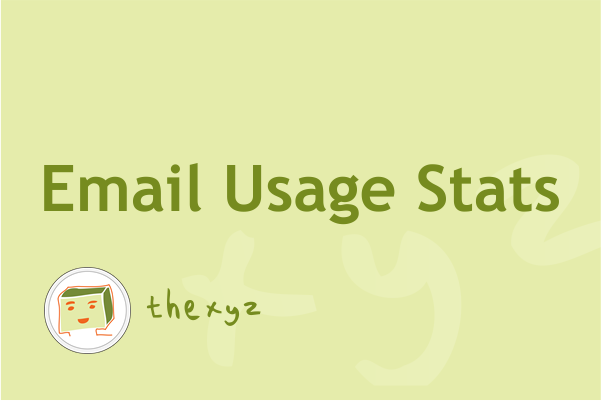With the internet becoming increasingly accessible globally, the number of emails sent and received each day continues to increase every year. While roughly 306.4 billion e-mails were estimated to have been sent and received each day in 2020, this figure is expected to increase to over 376.4 billion daily emails by 2025.
Number of emails sent each day
The total number of business and personal emails sent and received each day is forecast to grow to over 347 billion by year-end 2023. This figure is expected to increase to over 376.4 billion daily emails by 2025 (Source: Statista).
| Total worldwide emails sent per day | |
|---|---|
| 2019 | 293,600,000,000 |
| 2020 | 306,400,000,000 |
| 2021 | 319,6000,000,000 |
| 2022 | 333,200,000,000 |
| 2023 | 347,300,000,000 |
| 2024 | 361,600,000,000 |
| 2025 | 376,400,000,000 |
As the internet becomes more accessible to a greater number of people around the world. Email usage is also expected to increase.
Number of email users around the world
The number of worldwide email users is now over 4 billion and is expected to grow to over 4.3 billion users worldwide by the end of 2023. Since 2019 over half of the world’s population uses email.
| Total worldwide email users | |
|---|---|
| 2019 | 3,930,000,000 |
| 2020 | 4,037,000,000 |
| 2021 | 4,147,000,000 |
| 2022 | 4,258,000,000 |
| 2023 | 4,371,000,000 |
%
%
Growth in email users
The number of worldwide email accounts is expected to continue to grow at the rate of 3% per year.
Email use in America
90% of Americans aged 15 and over have active email accounts. 99% of users check their email at least once per day. More people use email on a mobile device with 42% of email now opened on a mobile device.
%
Americans with active email accounts
%
Gmail accounts make up 53% of US email mailboxes
%
49% of US workers checking their work email every few hours while they’re off duty
%
Percent of users that check email daily
%
79% of Americans check their email on vacation
%
42.3% of Americans subscribe to email lists to receive savings and discounts
Businesses choose email for marketing
Mobile devices are more popular than their desktop counterparts when it comes to email usage. Most people in the world consume online content primarily through their mobile devices, and email is no exception. It shouldn’t come as a surprise, then, that both Apple Mail and Gmail lead the pack among email clients. Another trend that we have recently seen with email is that more people are using Webmail over email clients.
- Apple iPhone 34.2%
- Gmail 30.7%
- Apple Mail 10.4%
- Outlook 7.3%
- Yahoo Mail 4.7%
- Apple iPad 1.7%
- Samsung Mail 1.6%
- Outlook Mobile 1.6%
- Google Android 1.2%
- Outlook.com 0.9%
Businesses choose email for content marketing
Email marketing generates $42 for every $1 spent, which is an astounding 4,200% ROI, making an email marketing strategy one of the most effective business marketing options available and a great way to boost your conversion rate. Email boasts the highest open rates for any form of outbound marketing. Take a look at the email marketing statistics below before you start searching for your next email templates to send emails. If you’re doing business in the developed world, your customers are using email, and you should be as well. No matter how small your business is, you have the ability to reach people through email marketing.
4 out of 5 marketers said they’d rather give up social media than email campaigns.
%
64% of small businesses use email marketing to reach customers
%
31% of B2B marketers say email newsletters are the best way to nurture leads
%
35% of email recipients open email based on the email subject lines alone
%
56% of brands using emoji in their personalized subject lines had a higher click through rates
%
Sending three abandoned cart emails results in 69% more orders than a single email
%
320% more revenue is driven from automated emails than non-automated emails
%
78% of marketers have seen an increase in email engagement over the last 12 months
%
Across all industries, the average email open rate is 19.8%
%
86% of professionals prefer to use email when communicating for business purposes
%
87% of marketers use email marketing to disseminate their content
%
Adding videos to your email can increase click rates by 300%
%
Adding a call-to-action button in your B2B emails instead of simply a text link can lead to a 28% increase in click-throughs
Marketing channels used by small businesses
In a survey by Campaign Monitor, small business owners ranked which forms of marketing were the most effective. What worked for them and what didn’t?
- Facebook 69.6%
- Email 64.1%
- Direct Mail 52.4%
- Instagram 48.3%
- Twitter 47%
- Print Ads 45.7%
- Paid Search 42.8%
Email Deliverability Rates
Ensuring your outbound email marketing campaign makes it to the inbox and is not caught by spam filters is paramount to success. Digital marketers often know the key to boosting deliverability rates – maintaining clean lists, keeping subscribers engaged, segmented campaigns, building a good sender reputation, etc. It is also important to use an email marketing solution that has a high email deliverability rate. These providers were tested in March 2021 and the average deliverability rate is listed.
- ActiveCampaign 91.1%
- AWeber 77.6%
- Benchmark 75.1%
- Constant Contact 91.5%
- GetResponse 83.8%
- Group List 97.2%
- MailChimp 86.9%
- Mailjet 89.6%
- Moosend 88.7%
Alarming Email Phishing and Abuse Stats
Email-based phishing and malware persist as a major security threat, with billions of attacks now occurring daily. In the first three months of 2020, according to a Phishing Benchmark Global Report, remote workers were hit with 30,000 more “suspicious messages,” and a 667% increase in COVID-related spear phishing.
As of July 31, 2021, the FBI IC3 has received over 16,000 sextortion complaints in 2021, with losses exceeding $8 million. Nearly half of these extortion victims were in the 20-39 age group. Victims over 60 years comprised the third largest reporting age group, while victims under the age of 20 reported the fewest number of complaints.
%
Only 3% of the users report phishing emails to the management
%
22% of all data breaches in 2020 involved phishing attacks
More than 60,000 phishing websites were reported in March
%
remote workers were hit with a 667% increase Covid-related phishing
%
Electronic extortion complaints rose 242%
%
Email threats against global businesses grew 64% in 2020 due to remote working
%
53% of all emails sent in 2020 were spam
%
30% of phishing emails are opened by users
%
As many as 85% of all organizations have been targeted by phishing scams in 2020.
Top 10 malicious attachments in email
This chart displays the most popular email viruses and threats over the past year. The most widespread malware in Q3 mail traffic was assigned the verdict Trojan-PSW.MSIL.Agensla.gen (8.44%). In second place was Exploit.MSOffice.CVE-2017-11882.gen (5.67%), while Trojan.MSOffice.SAgent.gen (4.85%) came third.
- Trojan-PSW.MSIL.Agensla 12.67%
- Trojan.Win32.Agentb 8.78%
- Exploit.MSOffice.CVE-2017-11882 8.03%
- Trojan.MSOffice.SAgent 5.67%
- Hoax.Script.Scaremail 5.57%
- Trojan.MSIL.Crypt 4.32%
- Trojan.Win32.Badun 4.06%
- Trojan.Win32.Kryptik 3.29%
- Trojan.Win32.ISO 2.59%
- Trojan.MSIL.Taskun 2.36%
This data illustrates the growing need for security awareness training initiatives that utilize real-world phishing simulations as a practical educational tool,
Top-level domains most popular with phishers
The most widespread malware in Q3 mail traffic was assigned the verdict Trojan-PSW.MSIL.Agensla.gen (8.44%). In second place was Exploit.MSOffice.CVE-2017-11882.gen (5.67%), while Trojan.MSOffice.SAgent.gen (4.85%) came third.
- .com 40.09%
- .xyz 5.84%
- .net 3%
- .ru 2.93%
- .buzz 2.57%
- .org 1.79%
- .info 1.53%
- .tk 1.47%
- .ml 1.30%
- .top 1.06%
- Other 38.42%
Who is targeted with phishing and malware?
Attackers largely focus their phishing and malware attacks on North America and Europe and both classes of attacks, the United States receives the highest volume of email attacks. This data was taken during a five-month observation window.
Number of phishing emails sent per day
- United States 28.4%
- Japan 10.9%
- India 6.8%
- United Kingdom 4.6%
- Brazil 3.7%
- Spain 3.6%
- France 2.7%
- Canada 2%
- Australia 2%
- Indonesia 1.9%
It’s fairly easy for an attacker to get hold of an email address and pretend to be somebody.
Top phishing attempts mimicking brands
Cybersecurity researchers at Check Point analyzed phishing emails sent during Q4 of 2020 and found that 43% of all phishing attempts mimicking brands were attempting to pass themselves off as messages from Microsoft. Microsoft is a popular target because of Office 365’s wide adoption among enterprises. By stealing these credentials, criminals aim to intrude and access corporate networks.
- Microsoft 43%
- DHL 18%
- LinkedIn 6%
- Amazon 5%
- Rakuten 4%
- IKEA 3%
- Google 2%
- PayPal 2%
- Chase 2%
- Yahoo 1%
Proportion of spam in mail traffic
During 2020, we analyzed the percentage of incoming email that was flagged as spam. The largest share of spam was recorded in February (56.32%). The average global mail traffic detected to be spam has been reduced in recent years. In 2009, 94% of all emails were spam and today this number seems to hover around 50%.
- January 53.23%
- February 56.32%
- March 54.31%
- April 53.09%
- May 52.75%
- June 51.89%
- July 49.26%
- August 50.38%
- September 48.39%
- October 48.23%
- November 47.74%
- December 47.28%
Spam accounts for 14.5 billion messages globally per day.
References
- Radicati
- Data Marketing Association
- https://terranovasecurity.com/2020-gpt-report/
- https://www.spamlaws.com/spam-stats.html
- https://www.zdnet.com/article/phishing-attacks-why-were-still-losing-the-battle-against-phoney-emails/
- https://blog.checkpoint.com/2021/01/14/brand-phishing-report-q4-2020/
- https://www.emailtooltester.com/en/email-deliverability-test/
- https://blog.hubspot.com/marketing/email-marketing-stats
- https://www.hubspot.com/marketing-statistics
- https://contentmarketinginstitute.com/wp-content/uploads/2019/10/2020_B2B_Research_Final.pdf
- https://www.litmus.com/blog/email-client-market-share-infographic/
- https://www.convinceandconvert.com/convince-convert/15-email-statistics-that-are-shaping-the-future/
- https://www.experian.com/assets/marketing-services/reports/transactional-email-report.pdf
- https://eleventygroup.com/2016/01/05/american-email-usage/
Dowwload Infographic
How can Thexyz help with Email Security?
Thexyz has a unique offering with its own private email hosting service which can be included with Hosted Exchange mailboxes on the same domain. This allows organizations who need Exchange-based email included with Office plans to realize significant savings. Not all users may require the more expensive Exchange functionality for email so having the ability to mix and match as needed can really help organizations save on IT expenses. Thexyz also offers business Office 365 plans, email migration services to and from Office 365, and additional email security services that can be used to strengthen the security of Office 365. It is also possible to purchase other Microsoft products and services, including the Office suite (including Word, Excel Powerpoint) outright, without the recurring costs. Contact us for more information on office applications without Microsoft 365 subscriptions.








Interesting data.
Some interesting data here on getting higher open rates with email campaigns. I will be sure to apply some of these findings to my next email blast. Thanks!
Keep up the good work, I’m very satisfied with TheXYZ email service.
wow, 300 billion emails are sent per day. I am still getting my head around that figure.
This is a nice-looking blog post. Keep em coming!